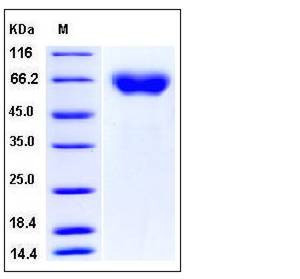Human Axl Kinase Protein (His Tag)
ARK,JTK11,Tyro7,UFO
- 100ug (NPP3586) Please inquiry
| Catalog Number | P10279-H08H |
|---|---|
| Organism Species | Human |
| Host | Human Cells |
| Synonyms | ARK,JTK11,Tyro7,UFO |
| Molecular Weight | The secreted recombinant human AXL consists of 428 amino acids after removal of the signal peptide and predicts a molecular mass of 46.5 kDa. In SDS-PAGE under reducing conditions, it migrates as an approximately 60-70 kDa band due to glycosylation. |
| predicted N | Glu 33 |
| SDS-PAGE |  |
| Purity | > 98 % as determined by SDS-PAGE |
| Protein Construction | A DNA sequence encoding the extracellular domain of human AXL isoform 1 (NP_068713.2) extracellular domain (Met 1-Pro 449) was fused with a polyhistidine tag at the C-terminus. |
| Bio-activity | |
| Research Area | Cancer |Signal transduction |Receptor Tyrosine Kinases (RTKs) |
| Formulation | Lyophilized from sterile PBS, pH 7.4 1. Normally 5 % - 8 % trehalose, mannitol and 0.01% Tween80 are added as protectants before lyophilization. Specific concentrations are included in the hardcopy of COA. |
| Background | Axl receptor tyrosine kinase, together with Tyro3 and Mer, constitute the TAM family of receptor tyrosine kinases. In the nervous system, Axl and its ligand Growth-arrest-specific protein 6 (Gas6) are expressed on multiple cell types. Axl functions in dampening the immune response, regulating cytokine secretion, clearing apoptotic cells and debris, and maintaining cell survival. Axl is upregulated in various disease states, such as in the cuprizone toxicity-induced model of demyelination and in multiple sclerosis (MS) lesions, suggesting that it plays a role in disease pathogenesis. Axl expression correlates with poor prognosis in several cancers. Axl mediates multiple oncogenic phenotypes and activation of these RTKs constitutes a mechanism of chemoresistance in a variety of solid tumors. Axl contributes to cell survival, migration, invasion, metastasis and chemosensitivity justify further investigation of Axl as novel therapeutic targets in cancer. The receptor tyrosine kinase AXL is thought to play a role in metastasis. The soluble AXL receptor as a therapeutic candidate agent for treatment of metastatic ovarian cancer. GAS6/AXL targeting as an effective strategy for inhibition of metastatic tumor progression in vivo. |
| Reference |
